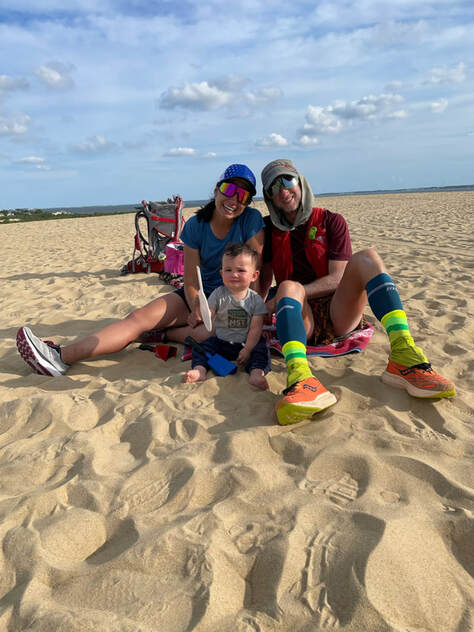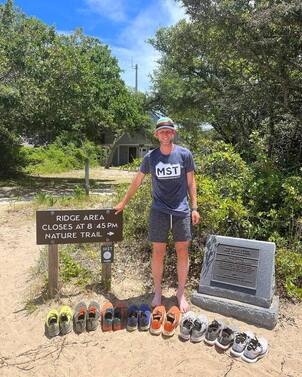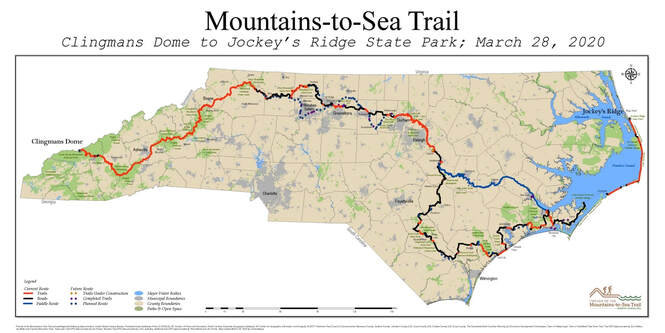Introduction by PPM Staff, Training Tips by Brandon Stapanowich In July 2021, we posted "Training Tips by Brandon Stapanowich," a blog post focused on tips for physical and mental preparedness for the Pikes Peak Ascent and Marathon. If you read that post, you may recall that Brandon Stapanowich has quite the mountain trail running resume. In fact, here are the Stap Stats we posted last year: 4:36 Pikes Peak Marathoner Competed in the Barkley Marathons Completed Nolan's 14 in under 60 hours Fastest self-supported time on Colorado Trail westbound 3rd place at Hurt 100 3rd place at Whistler Alpine Meadows 100 5th place at Run Rabbit Run 100 6th place at Hard Rock 100 12th place at Western States Invented 24 hours of the Incline: 22 ascents and descents for 44,000 feet gain/loss If that isn't enough, Brandon has been at it again, building his resume and creating more impressive stats. On June 7, 2022, Brandon set out to run the 1,175-mile Mountains-to-Sea Trail in North Carolina, which meanders across the entire state. Not only did Brandon take on this huge challenge, he set a goal of completing it in the fastest known time (FKT). And 23 days, 13 hours, and 28 minutes after he began this adventure, Brandon set the official FKT of the Mountains- to-Sea Trail. This epic journey was supported by his wife, Melissa, one year old son, Felix, and his family and friends. You can read more about the MST and Brandon's background in his blog post. You can also hear more about Brandon's journey on August 25 at The Colorado Running Company. Here in Colorado, Brandon is quite a local legend. With the Pikes Peak Ascent and Marathon getting closer by the day, we'd like to revisit Brandon's evergreen training tips - we're sure you can find something here to help you prep for the Peak! Training Tips from Brandon - With the passing of the longest day of the year, we are now officially in the summer season. This means that the Pikes Peak Ascent and Marathon are now less than 2 months away! I’m betting many of you are ramping up for the burliest parts of your training and, while I hold no running coach certifications, living and adventuring around Manitou Springs has taught me a thing or two about how to have a fulfilling experience on America’s Mountain. Below are some tips that come to mind: What’s in your legs: -In training, you want to simulate race conditions as closely as you can, particularly as you get closer to the event. Ideally you’ll be able to incorporate uphill running on your long runs, but don’t forget about shorter hill repeats (3-5 minutes). -If you don’t have hills nearby, you may consider trying to find stadium stairs or a treadmill. If none of those are an option, get creative by including speed work which will help you recruit additional muscle fibers, an outcome that is similar to that produced by uphill running. Doing a higher intensity workout for say 5 repetitions of 3-5 minutes will make that grind up the W’s a little less tiresome. -Don’t underestimate the power of a power hike. The vast majority of runners will be hiking at some point in the race, most likely above treeline. If you’ve practiced “walking with a purpose” in training, you’ll feel confident with doing it on race day. You can structure your power hike intervals just like running intervals and experiment with arm swing or placing your hands on your thighs to find a technique that suits you best. What’s in your pack: -Aid stations will have fluids and calories available, but if you’re interested in shaving some minutes off your time, use aid station resources as a supplement to what you can carry. -I typically aim for consuming 200 calories and 20 ounces of fluid an hour. Gels and chews can be easily consumed on the go, but for some, real food like bits of a granola bar work better. Either way, you want to be periodically sipping and snacking throughout the race rather than guzzling and gorging. -Running packs, handheld bottles, and waist packs come in a number of different varieties, each with their own pros and cons. Try different systems to see what works best for you, but whatever you choose, be sure it practice with it in training. That way, when you reach in that front left pocket, you’ll know with 100% certainty that you’ll be pulling out a gel and won’t spend any extra mental resources thinking about where it is. What’s in your head: -Limit the impact of the unknowns by studying the available information regarding the course, aid stations, and weather forecast. -Rehearse in your head how you’ll respond when things are going as planned or even better than planned. Then rehearse how you’ll respond when things don’t go as planned and how you’ll recover. -On race day, don’t over-think. Sometimes that’s easier said than done, but if you stay present and aware of your surroundings, and how you’re feeling, you’ll be more likely to make productive decisions when needed. One training workout will neither “make” or “break” the race. So as you continue to prepare, focus most on building consistent running throughout the weeks and months leading up to the race. In my eyes, the ultimate goal of racing is to have the most fun. Sometimes that means achieving a specific time or place goal, and sometimes it doesn’t. That’s up to you to define! Comments are closed.
|
©
Pikes Peak Marathon



